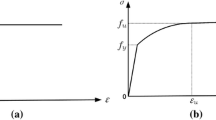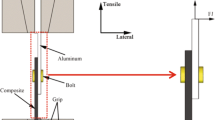Abstract
Bolted composite joints are the most common forms of connections in engineering structures. A numerical study has been carried out to investigate the tensile stress, shear stress and the bearing stress behavior of a plate containing bolted composite joints. It is necessary to determine stress around the joints in order to determine the site of crack initiation, which can severely reduce the overall strength of the structure. Finite element model for single-lap composite joint consists of eight laminates and bolt. The effect of alignment of fibers with respect to the loading direction on the site of crack initiation of composite bolted joints will be investigated. It can be concluded that, the site of crack initiation depends of fiber orientation. Furthermore, the site of crack initiation is almost interior the plate thickness.
Access this chapter
Tax calculation will be finalised at checkout
Purchases are for personal use only
Preview
Unable to display preview. Download preview PDF.
Similar content being viewed by others
References
J.-H Choi,. and Y.-J.Chun, “Failure Load Prediction of Mechanically Fastened Composite Joints,” Journal of Composite Materials, 2003, no. 37: 2163–2177.
Zhenqing Wang, Song Zhou, Jifeng Zhang, Xiaodi Wub, and Limin Zhou, “Progressive Failure Analysis of Bolted Single-Lap Composite Joint Based on Extended Finite Element Method,” Materials and Design, 2012, no. 37:582–588.
G. M. K. Pearce, A. F. Johnson, A. K. Hellier and R. S. Thomson, “A Stacked-Shell Finite Element Approach for Modeling a Dynamically Loaded Composite Bolted Joint Under in- Plane Bearing Loads,” Appl Compos Mater 21 March 2013.
H.-S. Ahn, J.-H. Kweon and J.-H. Choi, “Failure of Unidirectional-Woven Composite Laminated Pin-Loaded Joints,” Journal of Reinforced Plastics and Composites, 2005, no. 24: 735.
B. Yang, E. Pan and F.G, Yuan, “Three-Dimensional Stress Analyses in Composite Laminates with an Elastically Pinned Hole,” Int J. Solids Struct., 2003 no. 40: 2017–35.
G.S. Padhi, M.A. McCarthy, C.T. McCarthy and boljat, “A Tool for Designing Composite Bolted Joints Using Three-Dimensional Finite Element Analysis, “Composites: Part A, 2002, no. 33:1573–84.
Garth Pearce, Alastair Johnson, Rodney Thomson, and Donald Kelly, “Experimental Investigation of Dynamically Loaded Bolted Joints in Carbon Fiber Composite Structures.” Appl Compos Mater, 2010, no. 17:271–291
G. M. K. Pearce, A. F. Johnson, A. K. Hellier and R. S. Thomson, “A Stacked-Shell Finite Element Approach for Modeling a Dynamically Loaded Composite Bolted Joint Under in- Plane Bearing Loads,” Appl Compos Mater 21 March 2013.
ABAQUS analysis user’s manual. Version 6.7. Dassault Systèmes; 2007.
D.J. Cartwright, P. Parker, “Opening mode stress intensity factors for cracks in pin-loads joints” International Journal of Fracture, 1982, Vol. 18, no. 1, January 1982
Mustafa Ozen and Onur Sayman, “Failure Loads of Mechanical Fastened Pinned and Bolted Composite Joints with Two Serial Holes,” Composites Part B: Engineering, 2011, V. 42, no. 2:264–274.
R. Li, D. Kelly and A. Crosky, “Strength Improvement by Fiber Steering Around a Pin Loaded Hole,” Composite Structures j., 2002, no. 57: 377–383.
B. Okutan,”The Effects of Geometric Parameters on the Failure Strength for Pin loaded Multidirectional Fiber-glass Reinforced Epoxy Laminate,” Composites Part B, 2002, no. 33: 567–578.
B.M. Çten, and R. Karakuzu, “Progressive Failure Analysis of Pin-loaded Carbon epoxy Woven Composite Plates,” Composites Science and Technology, 2002, no. 62: 1259–1271.
B.M Çten, and O. Sayman, “Failure Analysis of Pin-loaded Aluminum-glass-epoxy Sandwich Composite Plates,” Composites Science and Technology, 2003, no. 63: 727– 737.
Author information
Authors and Affiliations
Editor information
Editors and Affiliations
Rights and permissions
Copyright information
© 2015 TMS (The Minerals, Metals & Materials Society)
About this chapter
Cite this chapter
Sallam, H.ED.M., Abd-Elhady, A.A. (2015). Prediction of Crack Initiation Site in Fastener Hole of Composite Laminate. In: Sano, T., Srivatsan, T.S. (eds) Advanced Composites for Aerospace, Marine, and Land Applications II. Springer, Cham. https://doi.org/10.1007/978-3-319-48141-8_14
Download citation
DOI: https://doi.org/10.1007/978-3-319-48141-8_14
Publisher Name: Springer, Cham
Print ISBN: 978-3-319-48607-9
Online ISBN: 978-3-319-48141-8
eBook Packages: Chemistry and Materials ScienceChemistry and Material Science (R0)




